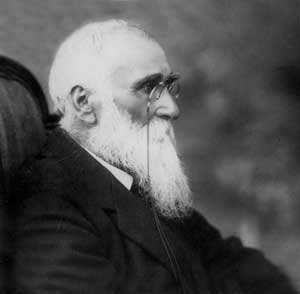Barnovi Vasil

Vasil Barnovi (Barnaveli) (born 22 May [3 June] 1856 or 1857, village Koda, now part of the Tetri Tskaro municipality—died 4 November 1934, Tbilisi) was a writer and one of the founders of the Georgian historical novel.
He was born into a priest’s family. His parents gave him an appropriate ედუცატიონ. At the age of 8, he was sent to the Tbilisi Seminary School and later to the Tbilisi Theological Seminary, from which he graduated in 1878. In 1882, he graduated with a Master's degree from the Moscow Theological Academy in history but chose teaching as his profession. From 1882 to 1902, he worked in Senaki, Telavi, and Tbilisi, gaining a reputation as a selfless, conscientious teacher of high intellectual caliber.
He was a member of the Writers' House of Georgia. His first essay, "A Few Insights into the Life of the Khevsurians," was published in the newspaper “Droeba” (Nos. 220-227) in 1878; his first poem, "The Georgian Woman," appeared in the same publication (1879, No. 149). From 1884 to 1887, he collaborated with the newspaper "Mtskemsi." His first original short story was "Little Levani" (1892, "Kvali," No. 2), and his first historical stories were “Sese” (1882, “Jejili”) and "Papuna" (1888). He began systematic literary activity in 1897–98.
Barnovi’s literary legacy includes more than forty short stories and novellas, which address the social problems raised at the end of the 19th and the early decades of the 20th century. This is particularly evident in his stories, which depict the final collapse of the feudal rule and the advance of capitalism ("Khurda," 1912; "The Wueens Belt," 1920), the rise of new morality ("The One Afflicted with Silver," "Tebera’s Betrothed," 1919; "The Unworthy," "The Snake’s Bliss," 1919, etc.), and the destruction of family foundations ("The Bound String," 1920). His philosophical short stories include "The Union of Souls," "The Soul that Sleeps," and "The Sweet Duduk" (1909). Love-themed stories include "Woe to He Who Loses You" (1901) and "Alucha." The writer pays special attention to the lives of artists and idealizes their existence ("Kharati," 1926; "Kharazi," "The Beauty of the Craftsman"). A significant part of his views and his long pedagogical practice was focuses on the proper upbringing of children ("Nushi," 1896; "The Crooked Tree," 1898; "Professor," 1901). He dedicated a significant part of his career to teaching and collaborated with the children’s journal "Jejili." His "Lessons in the History of Georgian Language" (1919) was the first school textbook on Georgian literature.
As a true master of historical fiction, he presented his first short story, "The Dawn of Isani," to the readers in 1901 (Moambe, No. 18). This was followed by his historical novels, one after another: "Dangerous Love" (1908), "The Dimmed Halo" (1914), "The Bride of the Khazars" (1919), "The Fall of Armaz" (1925), "Giorgi Saakadze" (1923–25), "The Queen of Byzantium" (1927), "The Sin of Youth" (1928), "Tamar the Mighty" (1929), "The Engulfed in the Light," "Iskander," and others. The historical facts and events presented in his works had never before been depicted on such a broad scale in the works of any Georgian writer. He was the first writer to use historical material not only to raise national issues but also to explore philosophical problems.
In his work, Barnovi used such techniques as contrast and parallelism. Many of his works are based on folklore ("The Iron Giant," "Lega’s Chokha," the novel "The Engulfed in the Light"). A distinctive feature of Barnovi’s language is his creative style, specifically his rhythmic prose.
Barnovi’s ideals, are based on the best traditions of Georgian classical thought. He has a significant and lasting presence in the modern Georgian literature.
Literary sources: თზულებანი, ტ. 1–10, თბ., 1961–64.
Literature: გომართელი ა., მოდერნისტი პატრიარქი (ვასილ ბარნოვის სიმბოლისტური პროზა), თბ., 1997; ვართაგავა ი., კრიტიკული წერილები, თბ., 1958; კოშორიძე ე., ვასილ ბარნოვის ენა ისტორიული რომანების მიხედვით, თბ., 1966; რადიანი შ., ვასილ ბარნოვის ისტორიული რომანები, თბ., 1944; ქიქოძე გ., ეტიუდები და პორტრეტები, თბ., 1958; ჩხეიძე ო., რომანი და ისტორია, თბ., 1965; ცისკარიძე ვ., უახლესი ქართული ლიტერატურის ისტორიის საკითხები, თბ., 1972; ჭილაია ს., უახლესი ქართული მწერლობა, თბ., 1972.
V. Tsiskaridze


